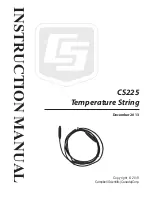
recording very slow DMX changes that in themselves might not change faster anyway. Often a setting
of 20 Hz will do ;ne, while allowing for twice as long recording as a 40 Hz setting.
Theoretically, the memory will hold for at least XXX seconds data in the worst-case situation, i.e. all 1,024
channels change each frame, recorded at 40 Hz. More realistic, a set-up using 100 dimmer channels
changing regularly, recorded at 30 Hz, may last XXXXX minutes.
By default, the recorder has 16 memories. You can reduce the number of memories in the settings page.
When you reduce the number of memories each memory will have more storing capacity, as the total
capacity used by all memories remains the same.
Recording
To make a recording ;rst select one of the memories. You may give it a name now or do this after
recording. Then set the desired refresh rate and select between DMX and Art-Net for the source. Then
press the MANUAL RECORD button. When you're ready press the STOP button. If the memory becomes
full the recording is stopped automatically.
You can use the CONSOLE RECORD button to simply copy the current output of the Console into a
recording (this recording will have one DMX frame).
Alternatively, you can have the recording started and stopped automatically if the timing needs to be
more precise than manual control. In order to make a 'triggered' recording appoint one DMX channel as
the trigger channel (choose from 1 till 1,024). Then press the TRIGGERED RECORD button. The memory
is now ready for recording, but the recording will only start when the trigger channel's value reaches
above 127. The recording is stopped as soon as the trigger channel goes below or equals 127. This allows
you to program the value of the trigger channel in your external DMX-512 or Art-Net console and time
the recording accurately.
Finally, you can also record a memory in sync with the time-code by using the TIME-CODE RECORD
button.
Playback
Each memory has an intensity value. When the intensity is set to a value other than 0, the memory will
be played back. The Art SSC is capable of simultaneous playback of 4 memories. When a ;fth playback is
set to playback, Art SSC will automatically stop the oldest playback (the one whose intensity level has
not altered for the longest time).
HTP/LTP
By default the values of all running playbacks are, with its intensity level taken into account, merged
together according to the Highest Takes Precedence (HTP) principle. The following table illustrates the
HTP system.
Playback 1
Playback 2
Playback 3
Merged Output
Channel 1
0%
0%
25%
25%
Channel 2
100%
0%
25%
100%
Channel 3
0%
0%
0%
0%
Channel 4
0%
100%
25%
100%
When set to LTP, only the last activated playback will send out its values. As soon as that playback is
stopped the one-but-last activated playback will be sending out.
20
















































